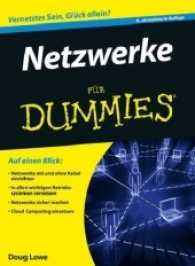- ホーム
- > 洋書
- > 英文書
- > Science / Mathematics
Full Description
The first edition of this book was published in 1978 and a new Spanish edition in 1989. When the first edition appeared, Professor A. Martin suggested that an English translation would meet with interest. Together with Professor A. S. Wightman, he tried to convince an American publisher to translate the book. Financial problems made this impossible. Later on, Professors E. H. Lieb and W. Thirring proposed to entrust Springer-Verlag with the translation of our book, and Professor W. BeiglbOck accepted the plan. We are deeply grateful to all of them, since without their interest and enthusiasm this book would not have been translated. In the twelve years that have passed since the first edition was published, beautiful experiments confirming some of the basic principles of quantum me chanics have been carried out, and the theory has been enriched with new, im portant developments. Due reference to all of this has been paid in this English edition, which implies that modifications havebeen made to several parts of the book. Instances of these modifications are, on the one hand, the neutron interfer ometry experiments on wave-particle duality and the 211" rotation for fermions, and the crucial experiments of Aspect et al. with laser technology on Bell's inequalities, and, on the other hand, some recent results on level ordering in central potentials, new techniques in the analysis of anharmonic oscillators, and perturbative expansions for the Stark and Zeeman effects.
Contents
8. Scattering Theory.- 8.1 Introduction.- 8.2 General Description of Scattering Processes.- 8.3 Cross Sections.- 8.4 Invariance of the Cross Section. Change LAB ? C.M..- 8.5 Simple Scattering: Classical Case.- 8.6 Simple Scattering: Quantum Case.- 8.7 Scattering Operator or S Matrix. Unitarity of the S Matrix.- 8.8 Intertwining Property and Energy Conservation.- 8.9 d?/d? as a Function of TE.- 8.10 Scattering into Cones.- 8.11 The Optical Theorem.- 8.12 Computation of the Scattering Amplitude.- 8.13 Space-Time Description of Simple Scattering.- 8.14 Symmetries of the Scattering Operator.- 8.15 Scattering by a Central Potential: Partial Waves and Phase Shifts.- 8.16 Computation and Properties of Phase Shifts.- 8.17 Scattering by a Central Square Well.- 8.18 Analyticity Properties of the Partial Amplitudes.- 8.19 Analyticity Properties of the Scattering Amplitude.- 8.20 Coulomb Scattering.- 8.21 Two Body Elastic Scattering.- 8.22 Multichannel Scattering.- 8.23 General Form of the OpticalTheorem.- 8.24 Symmetries in Multichannel Scattering.- 8.25 The Optical Potential.- 9. The W.B.K. Method.- 9.1 Introduction.- 9.2 The W.B.K. Method in One-Dimensional Problems.- 9.3 Connection Formulae.- 9.4 Bound State Energies.- 9.5 The Potential Barrier.- 9.6 The Miller-Good Method.- 9.7 Transmission by Double Potential Barriers.- 9.8 Potential Wells: Several Turning Points.- 9.9 Central Potentials.- 10. Time-Independent Perturbation Theory and Variational Method.- 10.1 Introduction.- 10.2 Time-Independent Perturbations. The Non-Degenerate Case.- 10.3 The Harmonic Oscillator with ?x4 Perturbation.- 10.4 The Harmonic Oscillator with ?x3 Perturbation.- 10.5 Two-Electron Atoms (I).- 10.6 Van der Waals Forces (I).- 10.7 Kato's Theory.- 10.8 The Stark Effect.- 10.9 The Variational Method.- 10.10 Two-Electron Atoms (II).- 10.11 Van der Waals Forces (II).- 10.12 One-Electron Atoms.- 10.13 Eigenvalues for Large Coupling Constants.- 11. Time-Dependent Perturbation Theory.- 11.1 Introduction.- 11.2 Nuclear Spin Resonance.- 11.3 The Forced Harmonic Oscillator.- 11.4 The Interaction Picture.- 11.5 Transition Probability.- 11.6 Constant Perturbations.- 11.7 Turning on Perturbations Adiabatically.- 11.8 Periodic Perturbations.- 11.9 Sudden Perturbations.- 11.10 The Adiabatic Theorem.- 11.11 The Adiabatic Approximation.- 11.12 The Decay Law for Unstable Quantum Systems.- 12. Particles in an Electromagnetic Field.- 12.1 Introduction.- 12.2 The Schrödinger Equation.- 12.3 Uncertainty Relations.- 12.4 The Aharonov-Bohm Effect.- 12.5 Spin-1/2 Particles in an E.M. Field.- 12.6 A Particle in a Constant Uniform Magnetic Field.- 12.7 The Fine Structure of Hydrogen-Like Atoms.- 12.8 One-Electron Atoms in a Magnetic Field.- 13. Systems of Identical Particles.- 13.1 Introduction.- 13.2 Symmetrization of Wave Functions.- 13.3 Non-Interacting Identical Particles.- 13.4 Fermi Gas.- 13.5 Bose Gas.- 13.6 Creation and Annihilation Operators.- 13.7 Correlation Functions.- 13.8 Superfluidity.- 13.9 Superconductivity.- 14. Atoms.- 14.1 Introduction.- 14.2 The Thomas-Fermi Method.- 14.3 The Hartree-Fock Method.- 14.4 The Central Field Approximation.- 14.5 Perturbative Calculations.- 14.6 Russell-Saunders or LS Coupling.- 14.7 jj Coupling.- 15. Quantum Theory of Radiation.- 15.1 Introduction.- 15.2 Plane Wave Expansions.- 15.3 Quantization of the E.M. Field.- 15.4 Multipole Waves.- 15.5 Interaction Between Matter and Radiation.- 15.6 Transition Probabilities.- 15.7 Emission and Absorption of Photons.- 15.8 Angular Distribution of Multipole Radiation.- 15.9 Electric Dipole Transitions in Atoms.- 15.10 Radiative Transitions in Nuclei.- 15.11 Low Energy Compton Scattering.- of Quantum Mechanics I.







